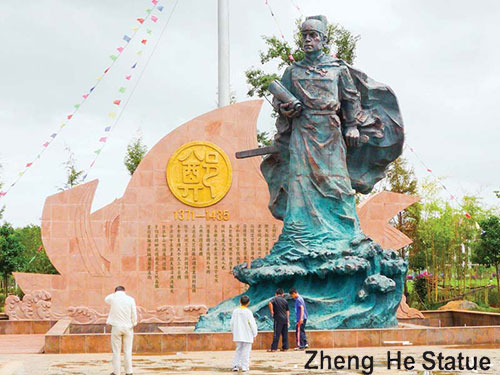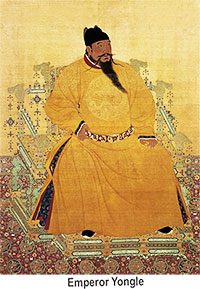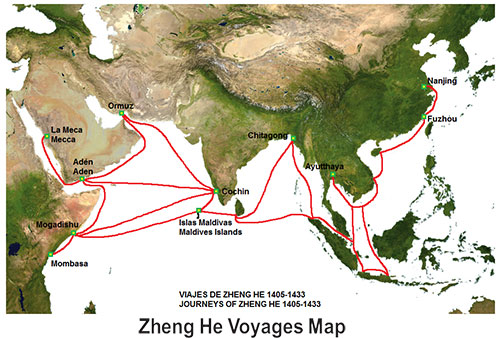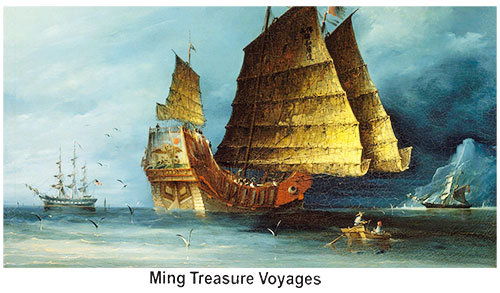Vira Alakeshvara’s PlightSignals from the Past
by Sasanka Perera
South Asian University
2021/04/28

I have a clear recollection of one of my teachers in the Advanced Level Sinhala class narrating the story of how a Sri Lankan ruler was kidnapped by a Chinese naval commander in the Kotte period. It was not part of the subject matter of his class. But as a well-read man, he knew the story and wanted to make a point about power and political interference. I cannot now remember what the exact context was. Over time, I also forgot who the Chinese belligerent was but always remember the local kidnap victim as Alakeshvara. In the annals of Sinhala heroism, Alakeshvara or Vira Alakeshvara comes up as an able military leader who is credited for establishing the fortifications of Kotte, which later became the main kingdom of Lanka and for bringing invading soldiers from the kingdom of Jaffna under control. He later captured power in Kotte and became the king and ruled for 12 years. But Alakeshvara’s plight at the hands of the Chinese is not part of this heroic discourse.
‘National defeats’ are hardly a part of public national memory anywhere in the world and not simply in Lanka. Moments of ‘shame’ are often forgotten or consciously erased in preference to what can be more easily and happily celebrated. As such, there is a deafening silence on the Chinese belligerence in the 15th century even though there are adequate references to the incident from records of the time as well as from the work of latter-day scholars such as Edward Dreyer, Louise Levathes, Senarath Paranavitana and others. All these sources collectively offer a reasonable sense of what happened not only in Lanka but the overall contexts and politics of Chinese naval expansion in the 15th century. It seems to me an understanding of this past is quite important to the present as well, given the way in which this ancient incident is embroiled in diplomatic, military and commercial interests.
Zheng He and the Ming Treasure Voyages

Recent readings reminded me that the locally forgotten story’s main character was Zheng He, who is sometimes also referred to as Cheng Ho. He was a well-known Chinese naval commander. According to existing reports, Zheng He and his fleet arrived in Lankan waters as part of what is known as ‘Ming Treasure Voyages.’ The seven voyages under this naval scheme took place between 1405 and 1433. This was the brainchild of Emperor Yongle of the Ming Court, who began setting up this fleet in 1403. These voyages, employing a large fleet, thousands of personnel and resources were undertaken on behalf of the Ming Dynasty and particularly on the instructions of Emperor Yongle to expand China’s military, political and commercial authority across the oceans.
The main intention of the seven voyages was to find local allies and establish Chinese spheres of influence if not complete control in different parts of Asia, parts of the Middle East and places like Mogadishu and Mombasa in East Africa. It is in this context one also can understand the politics of the trilingual inscription (Chinese, Persian and Tamil) discovered in 1911 in Galle that refers to the endowments Zheng He had presented to the Vishnu shrine at Devinuwara, Sri Pada, and to a mosque (perhaps in Galle). This is a subtle but obvious way of appealing to the socio-political sensibilities of large and important communities in the island at the time. All these interventions were made to ensure the safety and stability of maritime routes for Chinese vessels.
Unfortunately, Alakeshvara turned out to be an irritant in this grand global scheme simply because he did not perceive the overall and expansive agenda of the voyages but looked at them only from the perspective of his immediate local political circumstances. As a result, he was hostile to Chinese intentions in Lanka, particularly the attempts at expanding Chinese trade. Chinese trade was a key factor in the Lankan economy for a long time. As Prof Sudharshan Seneviratne has reminded me, the largest collection of overseas coins discovered in Yapahuwa is of Chinese origin. And it is no accident that Yapahuwa was right in the middle of the main trade route connecting the western coast with the spice and gem regions of the hills.
In this context, Alakeshvara launched what is generally referred to as ‘piracy’ attacks against Zheng He’s fleet in local waters. But to do this, one has to assume he had the support of some of the local ‘maritime powers’ from Mannar to Galle, who were mostly Muslim merchant chieftains because Chinese trade expansion might have impacted their margins of profit too. All this happened in the First Treasure Voyage of 1405. Given the nature of this local hostility, Zheng He took a strategic decision to leave Lankan waters. But as latter events would indicate, he did not forget what he considered Alakeshwara’s lack of courtesy and insulting behavior towards him.
Zheng He’s Revenge

The revenge of the Chinese came as part of the Third Ming Treasure Voyage. The main purpose of this voyage after its arrival in Lanka was to defeat Alakeshvara militarily. The confrontation with Alakeshvara took place in 1410 or 1411. Zheng He and his troops attacked Kotte and captured Alakeshvara, his family and key political figures allied with him. They were taken to China as prisoners. Yang Rong writing in 1515 in his text, Yang Wenmin Gong Ji (or The collected Works of Yang Rong) describes the battle in Kotte and its aftermath in the following somewhat disparaging words, referring to the locals as ‘noxious pests’ and ‘insignificant worms’: “Straight-away, their dens and hideouts we ravaged and made captive that entire country, bringing back to our august capital, their women, children, families and retainers, leaving not one, cleaning out in a single sweep those noxious pests, as if winnowing chaff from the grain.
These insignificant worms, deserving to die ten thousand times over, trembling in fear did not even merit the punishment of Heaven.” Zheng He’s action in Lanka and the kidnapping of one of its most powerful leaders of the time comes close to what contemporary military writers might call a ‘surgical strike,’ an attack with clinical accuracy in a short period of time to achieve a very specific objective. Crucially, this attack took place in a broader socio-political context using power projection across oceans that contemporary scholars would describe as gunboat diplomacy. However successful Zheng He’s operation might have been, it is unlikely that this expedition would have gone this smoothly without considerable local support even though there are no references to this in surviving Chinese records. But this was clearly a time of significant political turmoil within the powerful Alakeshvara family itself in addition to other powerful political actors including the family of the future king Parakramabahu the Sixth who were all looking for means to gain power.
In 1411, Zheng He brought his Lankan captives to the presence of the Ming Emperor Yongle, who later pardoned Alakeshvara and returned him to Kotte. This pardon is described by Yang Rong in the following words: “Thus the august emperor spared their lives, and they humbly kowtowed, making crude sounds and praising the sage-like virtue of the imperial Ming ruler.” But this debacle ensured that Alakeshvara’s political prestige and power were lost forever as was the political influence of his extended family. Consequent to Alakeshvara’s defeat, Parakramabahu the Sixth ascended the throne in Kotte. This is where we can see that Zheng He’s 15th-century surgical strike was much more than avenging an insult from a local leader.
It was part of a broader plan to enact regime change and ensure that a ruler more amenable to China’s intentions of the time was in control in Lanka. According to Chinese records referred to by Senarath Paranavitana and C. W. Nicholas in their book, A Concise History of Ceylon: From the Earliest Times to the Arrival of the Portuguese (1961), Parakramabahu the Sixth was chosen to be king by Sinhala emissaries present in the Ming Court at the time, nominated by Emperor Yongle and effectively installed by Zheng He using the military and naval power at his disposal. Irrespective of what might today be called ‘foreign interference’ in ensuring Parakramabahu the Sixth’s consolidation of power, he went on to become Lanka’s last ‘great’ king under whose rule the island was politically ‘unified’ which also ensured political stability and a phase of significant cultural revival. But more important to what I have described so far, he also created a political alliance with the Chinese that allowed expansive political projects such as the Ming Treasure Fleet easy access to local waters as well as local political support. But in Lanka, this important episode in our history is almost completely forgotten.
Signals from the Past

As I said at the beginning, this was a story initially narrated to me and my class by an erudite teacher in the early 1980s. It came back to my mind not only because it is an intriguing story from a time we have mostly forgotten or because one cannot easily find such well-read schoolteachers or even scholars in our country today, but because it says much about the present as it does of the time in which these incidents actually happened. I cannot shake off a feeling of déjà vu when I read this story today and look around to see powerful nations of contemporary times engaging in very similar activities in various parts of the world much of which are located in what is now known as the ‘Global South.’
But only the future would let us know if we were capable of reading the signals from the past accurately and were intelligent enough to refashion our present.

Leave a Reply
You must be logged in to post a comment.